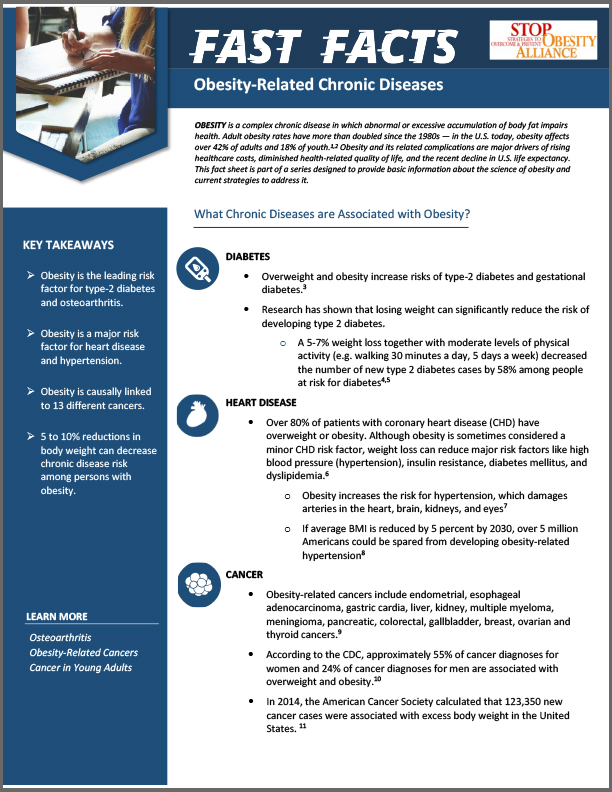Download: Fast Facts - Obesity-Related Chronic Disease (PDF)
OBESITY is a complex chronic disease in which abnormal or excessive accumulation of body fat impairs health. Adult obesity rates have more than doubled since the 1980s — in the U.S. today, obesity affects over 42% of adults and 18% of youth.1,2 Obesity and its related complications are major drivers of rising healthcare costs, diminished health-related quality of life, and the recent decline in U.S. life expectancy. This fact sheet is part of a series designed to provide basic information about the science of obesity and current strategies to address it.
Key Takeaways
- Obesity is the leading risk factor for type-2 diabetes and osteoarthritis.
- Obesity is a major risk factor for heart disease and hypertension.
- Obesity is causally linked to 13 different cancers.
- 5 to 10% reductions in body weight can decrease chronic disease risk among persons with obesity.
What Chronic Diseases are Associated with Obesity?
Diabetes
- Overweight and obesity increase risks of type-2 diabetes and gestational diabetes.3
- Research has shown that losing weight can significantly reduce the risk of developing type 2 diabetes.
- A 5-7% weight loss together with moderate levels of physical activity (e.g. walking 30 minutes a day, 5 days a week) decreased the number of new type 2 diabetes cases by 58% among people at risk for diabetes4,5
Heart Disease
- Over 80% of patients with coronary heart disease (CHD) have overweight or obesity. Although obesity is sometimes considered a minor CHD risk factor, weight loss can reduce major risk factors like high blood pressure (hypertension), insulin resistance, diabetes mellitus, and dyslipidemia.6
- Obesity increases the risk for hypertension, which damages arteries in the heart, brain, kidneys, and eyes7
- If average BMI is reduced by 5 percent by 2030, over 5 million Americans could be spared from developing obesity-related hypertension8
Cancer
- Obesity-related cancers include endometrial, esophageal adenocarcinoma, gastric cardia, liver, kidney, multiple myeloma, meningioma, pancreatic, colorectal, gallbladder, breast, ovarian and thyroid cancers.9
- According to the CDC, approximately 55% of cancer diagnoses for women and 24% of cancer diagnoses for men are associated with overweight and obesity.10
- In 2014, the American Cancer Society calculated that 123,350 new cancer cases were associated with excess body weight in the United States. 11
Stroke
- Obesity is associated with cardiometabolic conditions that increase individual long-term risk of heart disease and stroke, including: 8,12
- high blood pressure
- high levels of harmful blood fats (triglycerides)
- high levels of “bad cholesterol” (low-density lipoprotein, LDL)
- low levels of “good cholesterol” (high-density lipoprotein, HDL)
Osteoarthritis
- Obesity is a major risk factor for development of osteoarthritis (OA), particularly of the knee.
- Three-quarters of people with OA have overweight or obesity13
- Adults with obesity are up to four times more likely to develop OA of the knee than adults without obesity14
Under Investigation: Excessive Weight Gain in Early Adulthood
Approximately 1 in 4 women and 1 in 8 men gain 44 pounds or more between the ages of 18 and 55 years. New research suggests that preventing excessive weight gain during this period may be a promising target for intervention.
Weight gain ≥ 44 pounds during early to middle adulthood significantly increases chronic disease risk
1.5x more likely to die prematurely
among male non-smokers who gain ≥ 44 lbs from early to middle adulthood (21-44 year range)
1.4x more likely to die prematurely
among female non-smokers who gain ≥ 44 lbs from early to middle adulthood (21-44 year range)
- References
-
- Hales CM, Carroll MD, Fryar CD, Ogden CL. Prevalence of obesity and severe obesity among adults: United States, 2017–2018. NCHS Data Brief, no 360. Hyattsville, MD: National Center for Health Statistics. 2020
- Hales CM, Carroll MD, Fryar CD, Ogden CL. Prevalence of obesity among adults and youth: United States, 2015–2016. 2017.
- Centers for Disease Control and Prevention. Diabetes: Quick Facts. Atlanta, GA: U.S. Department of Health and Human Service. Accessed Aug 1, 2019.
- Hamman, R.F et al. Effect of weight loss with lifestyle intervention on risk of diabetes. Diabetes Care. 2006;29: 2102-2107.
- The Diabetes Prevention Program Research Group. The Diabetes Prevention Program. Diabetes Care, 25(12): 2165-71, 2002.
- Ades PA, Savage PD. Obesity in coronary heart disease: an unaddressed behavioral risk factor. Preventive Medicine, 2017;104, 117-119.
- Harvard Health. Blood pressure and your brain. https://www.health.harvard.edu/heart-health/blood-pressure-and-your-brain. Accessed October 1, 2019.
- Trust for America’s Health. F as in Fat. 2012. http://healthyamericans.org/assets/files/TFAH2012FasInFatFnlRv.pdf.
- National Cancer Institute. Obesity and Cancer. https://www.cancer.gov/about-cancer/causes-prevention/risk/obesity/obesity-fact-sheet. Accessed June 22, 2019.
- CDC. https://www.cdc.gov/media/releases/2017/p1003-vs-cancer-obesity.html. Accessed June 22, 2019.
- Islami F et al. Proportion and number of cancer cases and deaths attributable to potentially modifiable risk factors in the United States. CA Cancer J Clin. 2018;68: 31-54.
- Benjamin EJ, Virani SS, Callaway CW, et al. Heart disease and stroke Statistics—2018 update: A report from the American heart association. Circulation. 2018; 137(12): e67-e492.
- Arthritis Foundation. Arthritis Facts. https://www.arthritis.org/about-arthritis/understanding-arthritis/arthritis-statistics-facts.php. Accessed June 22, 2019.
- Felson DT and Zhang Y. An Update on the Epidemiology of Knee and Hip Osteoarthritis with a View to Prevention. Arthritis and Rheumatism, 41(8):1343–55, 1998.
A product of the Strategies to Overcome & Prevent (STOP) Obesity Alliance at the Sumner M. Redstone Global Center for Prevention & Wellness.




